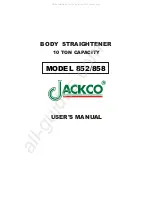
SW-Stahl und Werkzeugvertriebs GmbH
Tel. +49 (0) 2191 / 46438-0
F
5 6
e s s a r t S r e s u k r e v e L
ax +49 (0) 2191 / 46438-40
e d . l h a t s w s
@
o f n i : l i a
M - E
d i e h c s
m
e R 7 9 8 2 4 - D
Instruction Manual
BGS technic KG
Bandwirkerstr. 3
D-42929 Wermelskirchen
Tel.: 02196 720480
Fax.: 02196 7204820
www.bgstechnic.com
Warning
: The warnings, cautions, and instructions discussed in this instruction manual cannot cover
all possible conditions and situations that may occur. It must be understood by the operator that
common sense and caution are factors which cannot be built into this product, but must be supplied
by the operator.
Unpacking
When unpacking, check the content
to make sure that all of following parts are included.
1 Female Quick Connector
2 Metric Adapter M12 x 1.25
3 Metric Adapter M14 x 1.5
4 Test Hose
5 Dial Gauge Base
6 Leakage Dial Gauge
7 Pressure Dial Gauge
8 Air Inlet (Male Quick Connector)
9 Pressure Regulator
10 Adapter Hose
About Cylinder Leakage Testing
A Cylinder Leakage Tester can give you valuable information about the engines compression. Pressurized
air is supplied to each cylinder and the rate of leakage is measured in percent loss from 0% to 100%. The
operator may also locate the source of the compression loss by listening at these places:
⇒
Oil dipstick tube for leaking piston rings.
⇒
Radiator cap for leaking cylinder head gasket.
⇒
Exhaust tailpipe for leaking outlet valve.
⇒
Intake manifold for leaking intake valve.
If you are not experienced in doing this type of diagnostic test, the work should be done by a qualified
technician.
Important considerations about compression loss testing
1. There will always be some compression loss past piston rings, even in a new engine. You will never
see a 0% compression loss and this lost pressure should be audible at the oil dipstick port
2. If the Leakage Gauge shows very high or 100% compression loss, the cylinder may not be at Top
Dead Center (TDC) on the compression stroke. Check to be sure the cylinder is at TDC, so the valves
are closed. Reference your vehicle owner's manual for instructions on how to do this.
3. A "good" reading will show compression loss of all cylinders at about the same rate. A large difference
of 15% to 30% comparing one cylinder to the others indicates a problem.
4. Leakage rate readings may vary by up to 1 0% when taking repeated readings of the same cylinder
Piston position and engine temperature can cause variable readings Take several readings and
average the results by a recorded reading for each cylinder
5. Diagnosing an engine problem with this tool involves using a listening device (not included). A
mechanic's stethoscope are suggested.
6. The lower the sound pitch of escaping pressure indicates a larger leak. Small leaks will typically make
a higher pitched sound.
7. If the Vehicle has multiple problems, the Cylinder Leakage Tester may show only the most pronounced
problems. A large problem may overwhelm a smaller problem during testing.





















